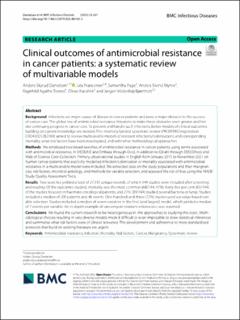| dc.description.abstract | Background Infections are major causes of disease in cancer patients and pose a major obstacle to the success of cancer care. The global rise of antimicrobial resistance threatens to make these obstacles even greater and hinder continuing progress in cancer care. To prevent and handle such infections, better models of clinical outcomes building on current knowledge are needed. This internally funded systematic review (PROSPERO registration: CRD42021282769) aimed to review multivariable models of resistant infections/colonisations and corresponding mortality, what risk factors have been investigated, and with what methodological approaches. Methods We employed two broad searches of antimicrobial resistance in cancer patients, using terms associated with antimicrobial resistance, in MEDLINE and Embase through Ovid, in addition to Cinahl through EBSCOhost and Web of Science Core Collection. Primary, observational studies in English from January 2015 to November 2021 on human cancer patients that explicitly modelled infection/colonisation or mortality associated with antimicrobial resistance in a multivariable model were included. We extracted data on the study populations and their malignancies, risk factors, microbial aetiology, and methods for variable selection, and assessed the risk of bias using the NHLBI Study Quality Assessment Tools. Results Two searches yielded a total of 27,151 unique records, of which 144 studies were included after screening and reading. Of the outcomes studied, mortality was the most common (68/144, 47%). Forty-five per cent (65/144) of the studies focused on haemato-oncological patients, and 27% (39/144) studied several bacteria or fungi. Studies included a median of 200 patients and 46 events. One-hundred-and-three (72%) studies used a p-value-based variable selection. Studies included a median of seven variables in the final (and largest) model, which yielded a median of 7 events per variable. An in-depth example of vancomycin-resistant enterococci was reported. Conclusions We found the current research to be heterogeneous in the approaches to studying this topic. Methodological choices resulting in very diverse models made it difficult or even impossible to draw statistical inferences and summarise what risk factors were of clinical relevance. The development and adherence to more standardised protocols that build on existing literature are urgent. | |
